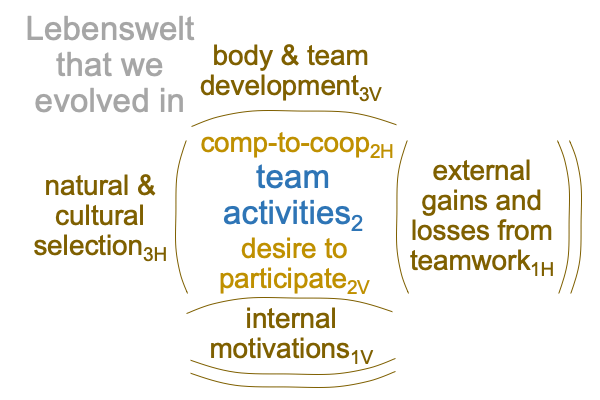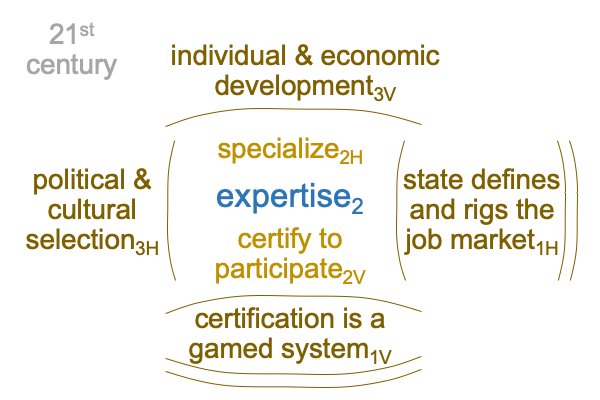Looking at Heather Heying and Bret Weinstein’s Book (2020) “A Hunter Gatherer’s Guide to the 21st Century” (Part 13 of 16)
0073 For purposes of this examination, I will look closely at chapter five (Food).

0074 Guidance2, the intersection of professors2H and podcasting2V, enters into the nested form of postmodern internet education3 and situates the possibility of the authors’ disciplinary expertise along with their mission (which is to join your team at the same time that you join theirs)1.
0075 The chapter starts with two warnings. First, there is no fixed recipe as to what to eat. Second, food is not merely nutrition for survival. Eating food occasions social engagement. Yes, cooking is important. So, is eating with others. Know the culinary habits of your lineage.
Here is a picture of what the authors are offering.

0076 Here is how they proceed. Place food2 in the place for species2 as the single actuality2 that is composed of adaptation2H and phenotype2V. Then, consider the following intersection from more than one point of view.

0077 The first adaptation2H that comes to mind is cooking with fire2H. What does fire do to raw food? Elevated temperatures break down cellular and structural impediments to digestion. Cooked food provides more calories than raw.
The corresponding phenotype2V includes changes in the ways that we perceive flavors. Cooked food tastes good. But, that is not all. Cooking offers an occasion for everyone to eat together and talk. In the Lebenswelt that we evolved in,humans practice hand talk, which means that no one talks while eating raw food. But, with cooked food, one does not have to eat and eat and eat and chew and chew and chew to get nutrition. Plus, cooked food tastes better! Plus, afterwards, everyone can sit around the fire and enjoy conversation.
In this respect, after the domesticatin of fire, hunter and gatherers have it good.

0078 But, what about our current Lebenswelt? What about the 21st century?
0079 Our current Lebenswelt is one of specialization. After the mechanical revolution starting in the early 1800s, specialization increases beyond imagination. All sorts of new species of “food for humans” arise in the 21st century. And, one popular item is called, “fast food”.
On the horizontal axis, the normal context of product selection3H brings the actuality of processed food2H into relation with the potential of industrial food processing1H.
On the vertical axis, the normal context of business development3V brings the actuality of restaurants2V in line with commercialization1V. Commercialization1V appears to be like the genome1V. Think of brand recognition. Each brand has a slogan. Slogans are the DNA of advertising.
0080 Here is the resulting interscope.

0081 Well, that is my guess as to how the author’s discussion plays out.
Every inquirer will come up with a different scenario.
That is one beauty of this type of exercise.
0082 Once can replace restaurants with diet regimes. Once can replace processed food with vitamin supplements.
On top of that, different topics are available. Fire is just one. Fire is domesticated in the Lebenswelt that we evolved in.
What about other domestications?
Animal and plant domestication occurs much more recently. Sometimes it is hard to tell whether animal and plant domestication begins in the Lebenswelt that we evolved in as opposed to our current Lebenswelt. Dogs are domesticated in the Lebenswelt that we evolved in. What about pigeons?
0083 The topic of food shows me that there is a big difference between cooking2H and eating2V in the Lebenswelt that we evolved in and processed foods2H and restaurants2V in our current Lebenswelt. Guidance is required. Guidance2 is the single actuality that combines the professor2H and the podcaster2V.
























